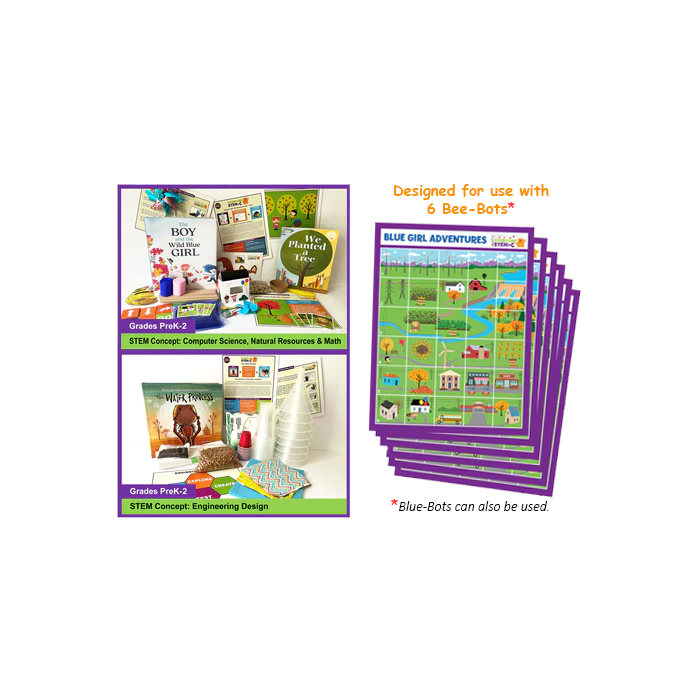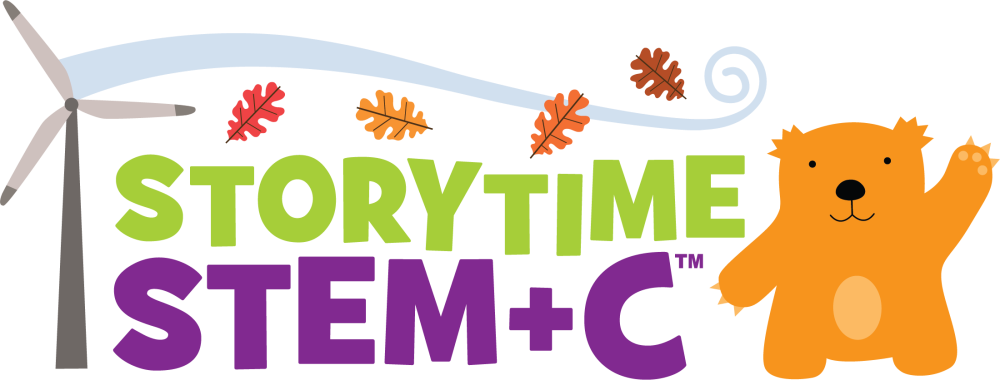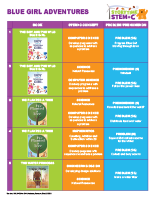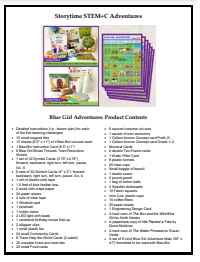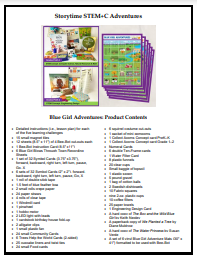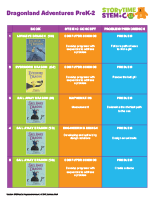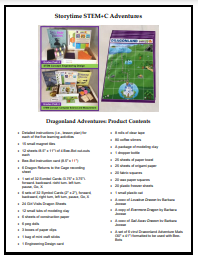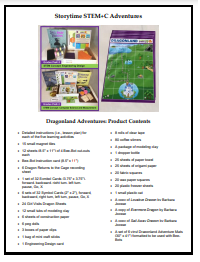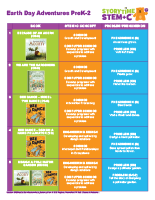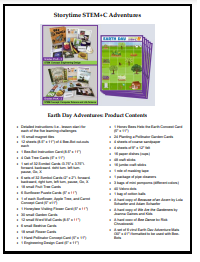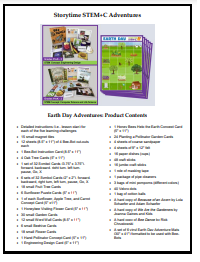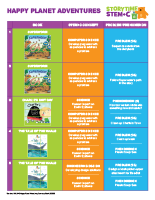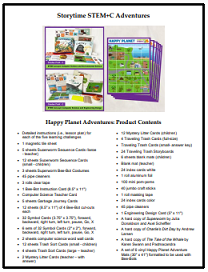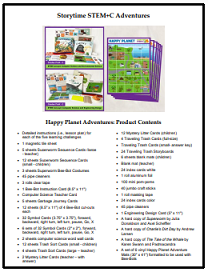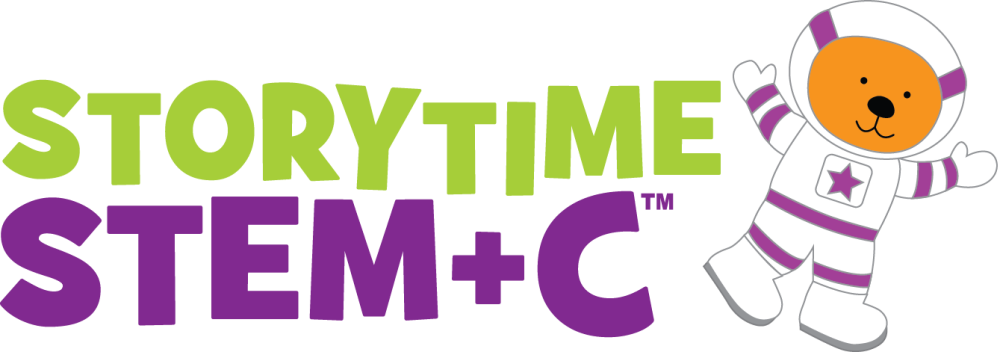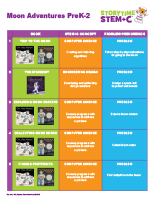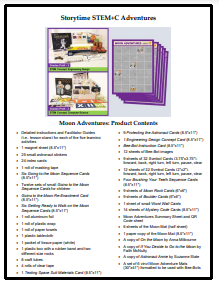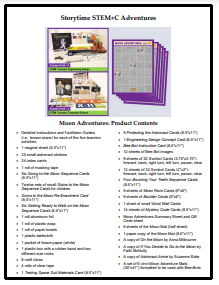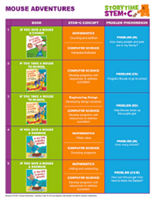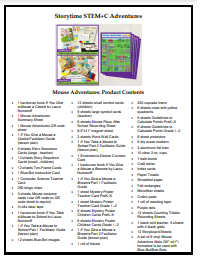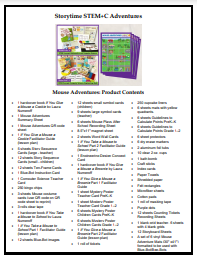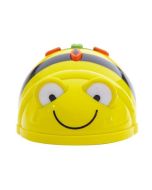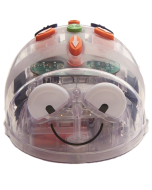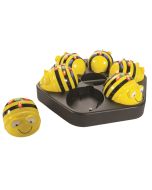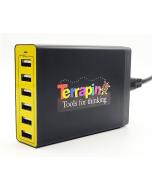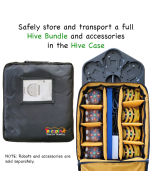Storytime STEM+C Adventures
Storytime STEM + Computer Science Adventures engage students through stories and colorful story-themed mats for Bee-Bots and Blue-Bots to explore. These enticing activities for young learners are a fun and effective way to build a great foundation in computational thinking and STEM connected through children’s literature.
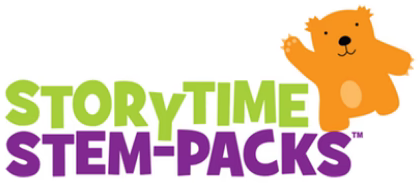 Each of the STEM+C Adventures were developed by the Allegheny Intermediate Unit Math & Science Collaborative as part of a National Science Foundation I-Corps grant. The kits and all their materials have been designed for use with Bee-Bots and/or Blue-Bots, and consist of 5 integrated activities that each take 45 minutes to implement and are suitable for grades PreK-2.
Each of the STEM+C Adventures were developed by the Allegheny Intermediate Unit Math & Science Collaborative as part of a National Science Foundation I-Corps grant. The kits and all their materials have been designed for use with Bee-Bots and/or Blue-Bots, and consist of 5 integrated activities that each take 45 minutes to implement and are suitable for grades PreK-2.
Each Adventure includes:
• 3 popular children’s books
• 6 identical story-themed vinyl mats (30" x 41")
• Facilitator guides
• All hands-on and print materials for 24 children
• Dozens of additional supporting materials
The Blue Girl Adventures activities are:
- The Boy and the Wild Blue Girl Part 1 - STEM+C Concept - Computer Science: Develop programs with sequences to address a problem
This challenge starts with reading the book The Boy and the Wild Blue Girl, a story inspired by the work of Poul la Cour, a pioneer of wind turbines. Children put blue hair on Bee-Bot to turn it into the Blue Girl and then program Girl-Bot to blow through town on a colorful vinyl mat featuring landmarks from the story. Symbol cards are provided and help children keep track of and debug their programs. - The Boy and the Wild Blue Girl Part 2 - STEM+C Concepts - Science: Natural Resources + Computer Science: Develop programs with sequences to address a problem
Children make streamers and observe a pinwheel to explore how moving air (wind) acts on objects. They then observe how a simple windmill can light an LED in the cardboard “birthday house” that they know from the story. Next, they program Girl-Bot to follow the power lines from the wind farm to bring electricity to different places in the community. - We Planted a Tree Part 1 - STEM+C Concepts - Science: Natural Resources + Computer Science: Develop programs with sequences to address a problem
Children listen to the story We Planted a Tree, seeing people from different parts of the world planting trees in their community. Using custom-made colorful cards, the children are challenged to think about how trees help the word. They then attach a basket to Girl-Bot and program Girl-Bot to bring fruits and vegetables from the farm to different places in the community. - We Planted a Tree Part 2 - STEM+C Concepts - Mathematics: Counting, Addition, and Subtraction within 20 + Computer Science: Develop programs with sequences to address a problem
Referring back to the book, children discuss how trees provide acorns for squirrels. They dress Bee-Bot so it becomes Squirrel-Bot. The children then use the basket to retrieve acorns (pom-poms) from the mat and count them. They get deeper into addition and subtraction as they help Squirrel-Bot store acorns for the winter, making additional trips on the mat. - The Water Princess - STEM+C Concepts - Engineering Design: Developing and optimizing design solutions + Science: Natural Resources
Children listen to the story of the Water Princess, following along as she and her mother walk all day to fetch water for the family. They think about how they could help the water princess make clean water. Using simple materials, children then plan, make, and test a simple water filter to clean muddy water.
NOTE -- The Blue Girl Adventures were designed for use with Bee-Bots, though Blue-Bots may also be used.
The Dragonland Adventures activities are:
- Lovabye Dragon - STEM+C Concept - Computer Science: Develop programs with sequences to address a problem
This computer science challenge starts with reading the book Lovabye Dragon, a heartwarming story about the friendship of a dragon and a girl. Transforming Bee-Bot into Dragon-Bot, children set out to re-enact scenes from the book by programming Dragon-Bot to move around on the colorful Dragonland vinyl mat. Symbol cards are provided and help children keep track of and debug their programs. - Evermore Dragon - STEM+C Concept - Computer Science: Develop programs with sequences to address a problem
This computer science challenge starts with reading Evermore Dragon, a sequel to Lovabye Dragon. Children program Dragon-Bot to hide behind a rock and find the hidden girl. They also practice listening carefully to each other during an unplugged activity. - Sail Away Dragon – Determine the Shortest Path - STEM+C Concept - Mathematics and Computer Science: Measurement
This computer science challenge starts with children reading Sail Away Dragon, the third sequel in the series. Acting on parts of the story, children determine the shortest path from the castle to the sea, using non-standard measurement tools on the vinyl mat. The activity concludes with children programming Dragon-Bot to following the path they laid out. - Sail Away Dragon – Design an Umbrella - STEM+C Concept - Engineering Design: Developing and optimizing design solutions
This Storytime STEM-Pack includes all the materials you need to engage kids in an engineering design task that also explores the concept of properties of matter. The activity is launched by referring back to the book Sail Away Dragon and making observations on some of the pages. Children are then challenged to think about how to keep the girl and the cat dry. They work in groups of three to design and test umbrellas, choosing from several materials and testing the umbrellas with water drops. - Sail Away Dragon – Create A Dance - STEM+C Concept - Computer Science: Develop programs with sequences to address a problem
This computer science challenge starts with children revisiting pages from the book Sail Away Dragon, where Girl and the Dragon danced the jig. They are then programming the robot to create their own Dragon-Bot dance.
NOTE -- The Dragonland Adventures were designed for use with Bee-Bots, though Blue-Bots may also be used.
The Earth Day Adventures activities are:
- Because of An Acorn - STEM+C Concepts - Science: Growth and Development + Computer Science: Develop programs with sequences to address a problem
This challenge starts with reading the book Because of an Acorn, describing the events set in motion by an acorn on the forest floor. Children learn more about the development of a tree and then program Bee-Bot to visit an oak tree and fruit trees on the colorful Earth Day vinyl mat. Symbol cards are provided and help children keep track of and debug their programs. - We are the Gardeners - STEM+C Concepts - Science: Growth and Development + Computer Science: Develop programs with sequences to address a problem
This computer science challenge starts with reading We are the Gardeners, following a family as they plan and plant a garden. Children learn about structure and function of plants and program Bee-Bot to water vegetables and plants in the garden, planning out their own paths on the Earth Day mat. - Bee Dance – Model the Dance - STEM+C Concepts - Science: Information Processing + Computer Science: Develop programs with sequences to address a problem
This integrated challenge starts with children reading Bee Dance, a beautifully illustrated children’s book that follows a honey bee scout as she finds a patch of prairie flowers and communicates their location to her hive mates by performing a dance. Acting out the story, children program Bee-Bot to move from the hive to flowers and then dance to indicate the distance they traveled. - Bee-Dance – Design a Hand Pollinator - STEM+C Concepts - Engineering Design: Developing and optimizing design solutions + Science: Independent Relationships in Ecosystems
Referring back to the Bee Dance book, this adventure engages children in exploring the relationship between plants and honey bees, and challenges them to build, test, and improve a hand pollinator, choosing from several provided materials. - Design a Pollinator Garden - STEM+C Concepts - Engineering Design: Developing and optimizing design solutions + Computer Science: Develop programs with sequences to address a problem
This culminating challenge asks children to reflect on how honey bees help people. Drawing on what they learned about plants and honey bees, it challenges the children to help honey bees by planning a pollinator garden and use Bee-Bot to share their solution by visiting story cards they created.
NOTE -- The Earth Day Adventures were designed for use with Bee-Bots, though Blue-Bots may also be used.
The Happy Planet Adventures activities are:
- Superworm Part 1 - STEM+C Concept - Computer Science: Develop programs with sequences to address a problem
This challenge starts with reading the book Superworm, the entertaining story of Superworm and his friends defeating the evil lizard wizard. Children use a pipe cleaner to change Superworm into a new creation (or into something different) and then sequence the events of the storybook. They transform Bee-Bot into Superworm-Bot with cardboard cut-outs and explore how the robot works. - Superworm Part 2 - STEM+C Concept - Computer Science: Develop programs with sequences to address a problem
Children program Superworm to rescue a toad from the road on a colorful vinyl mat featuring landmarks from the story and then re-enact the path of Superworm as it is kidnapped by the evil lizard wizard. Symbol cards are provided and help children keep track of and debug their programs. - Charlie’s Dirt Day - STEM+C Concepts - Science: Human Impact on Earth Systems + Computer Science: Develop programs with sequences to address a problem
Children listen to the story Charlie’s Dirt Day, watching people go to the park to take home free dirt for gardening. They explore how we can turn waste into something new and useful by learning about compost using Trash Sort Cards and a colorful Compost Concept Card. They program Bee-Bot to pick up free dirt and clean up Charlie’s town. - The Tale of the Whale Part 1 - STEM+C Concepts - Computer Science: Develop programs with sequences to address a problem + Science: Human Impact on Earth Systems
Children listen to the captivating story of the Tale of the Whale. They use colorful Traveling Trash cards to explore cause and effect relationships between littering and "plastic soup sea," and then they apply that learning to create their own Traveling Trash Storyboard. Programming Bee-Bot with an algorithm shown on the Mystery Litter cards, they find different trash items on the Happy Planet mat to clean up. - The Tale of the Whale Part 2 - STEM+C Concepts - Engineering Design: Developing and optimizing design solutions + Science: Human Impact on Earth Systems
Children revisit the Tale of the Whale story and discuss how they can help the animals in the ocean. Using simple materials, children then plan, make, and test a trash picker-upper attachment for Bee-Bot to clean up trash on the mat and take it to the landfill.
NOTE -- The Happy Planet Adventures were designed for use with Bee-Bots, though Blue-Bots may also be used.
The Moon Adventures activities are:
- Trip to the Moon - STEM+C Concept - Computer Science: Creating and Following Algorithms
This unplugged computer science activity starts with reading the book On the Moon (PreK-K) or If You Decide to Go to the Moon (Grades 1-2), creating excitement about a trip to the moon. Children then sequence a set of six Going to the Moon cards, justifying their proposed sequence. The activity concludes with a reenactment of a trip to the Moon, ending with everyone “walking” on the Moon. - Astronaut Annie - STEM Concept - Engineering Design: Developing and Optimizing Design Solutions
This Storytime STEM-Pack includes all the materials you need to engage kids in an engineering design task that also explores the concept of properties of matter. The activity is launched by reading the popular children's book, Astronaut Annie. Children are then challenged to think about how to protect an astronaut in space. They work in groups of three to design and test two layers of a space suit, choosing from several materials and testing materials with a rock. - Exploring Moon Craters - STEM+C Concept - Computer Science: Develop programs with sequences to address a problem
This computer science challenge starts with children revisiting pages with craters from the books and then sequencing a different set of six cards (Getting Ready to Walk on the Moon cards). Children then have an opportunity to become familiar with the robot (Bee-Bot), before completing the first challenge on the Bee-Bot Moon Mat, going from the Moon lander to the Moon buggy to explore craters (and back for older children). Children discuss the different strategies they used to determine how to program Bee-Bot. During the last part of the activity, children are using symbol cards (forward, backward, turn right, turn left, pause) to document Bee-Bot's movements. Possible extensions to visit multiple craters are provided. - Collecting Moon Rocks - STEM+C Concept - Computer Science: Develop programs with sequences to address a problem
This computer science challenge starts with children revisiting pages with moon rocks from the books and then sequencing a set of four cards (Brushing Teeth), or telling which card is missing, before coming up with their own sequence for a daily life experience. Next, the children program Bee-Bot to collect Moon rocks (cards), avoiding boulders (cards) for older children. To close, the children reflect and share how they worked as computer programmers, and what made them successful. - Finding Footprints on the Moon - STEM+C Concept - Computer Science: Develop programs with sequences to address a problem
This computer science challenge starts with children revisiting pages from the book with footprints on the moon surface and then asks children to program Bee-Bot to follow a “NASA Mystery Code.” If commands are followed correctly, Bee-Bot lands on a square of the Moon Mat that has astronaut footprints. Next, children program their robot to “go home” along a masking tape line, after discussing strategies on how to best program Bee-Bot to stop as close to the end of the line as possible. The activity concludes with a discussion on computing all around us in daily life.
NOTE -- The Moon Adventures were designed for use with Bee-Bots, though Blue-Bots may also be used.
The Mouse Adventures activities are:
- If You Give a Mouse a Cookie - STEM+C Concepts - Computer Science: Hardware/Software + Mathematics: Counting and Addition
This challenge starts with reading the book If You Give a Mouse a Cookie, and then having children sequence the events in this fun story. Next, the children draw a family picture and use counters and ten frames to represent the number of family members. They work with others to make addition come to life in context, as they find the total number of family members from two or more children. Last, children transform Blue-Bot into Mouse-Bot with cardboard cut-outs and explore how the robot works. - If You Take a Mouse to School - Part 1 - STEM+C Concept - Computer Science: Develop programs with sequences to address a problem
After listening to the story, children program Mouse-Bot to go from home to school and then to play after school on a colorful vinyl mat featuring landmarks from the story. Symbol cards are provided and help children keep track of and debug their programs. - If you Take a Mouse to School - Part 2 - STEM+C Concepts - Engineering Design: Developing and optimizing design solutions + Computer Science: Develop programs with sequences to address a problem
Children revisit the story and discuss how they can help Mouse clean up the purple goo mess from the science experiment. They watch a purple bath bomb "explode," simulating the science experiment from the book. Using simple materials, children plan, make, and test a clean-up tool for Mouse-Bot to soak up the purple goo. At the end, they program Mouse-Bot to clean up "messy" areas around the school, going to purple dots placed on the vinyl mat. - If You Give a Mouse a Brownie - Part 1 - STEM+C Concepts - Mathematics: Place value + Computer Science: Decoding problems
Children listen to the captivating story If You Give a Mouse a Brownie. Enacting scenes from the book, they engage in a counting collection activity, counting tickets that Mouse made for his rock concert. Then they decode programs shown on Mystery Cards to determine where Mouse has placed his rock concert posters around the town. - If You Give a Mouse a Brownie - Part 2 - STEM+C Concepts - Mathematics: Adding and subtracting + Computer Science: Develop programs with sequences to address a problem
Children send Mouse on a new adventure trying to make the most efficient route possible to get to places on the vinyl mat of their choosing. They use guidelines to map out their route, with the goal of avoiding certain obstacles, but jumping in as many puddles as possible, keeping track of the points they receive. A storyboarding activity provides an English Language Arts extension.
NOTE -- The Mouse Adventures were designed for use with Blue-Bots, though Bee-Bots may also be used. The only difference you will encounter appears in the fifth activity, where Blue-Bot's remote control ability to use 45-degree turns is used.

